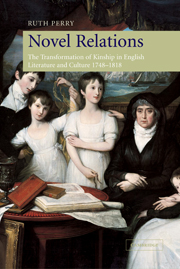Book contents
- Frontmatter
- Contents
- Acknowledgments
- Introduction
- 1 The great disinheritance
- 2 Fathers and daughters
- 3 Sister-right and the bonds of consanguinity
- 4 Brotherly love in life and literature
- 5 Privatized marriage and property relations
- 6 Sexualized marriage and property in the person
- 7 Farming fiction: Arthur Young and the problem of representation
- 8 The importance of aunts
- 9 Family feeling
- Bibliography
- Index
3 - Sister-right and the bonds of consanguinity
Published online by Cambridge University Press: 22 September 2009
- Frontmatter
- Contents
- Acknowledgments
- Introduction
- 1 The great disinheritance
- 2 Fathers and daughters
- 3 Sister-right and the bonds of consanguinity
- 4 Brotherly love in life and literature
- 5 Privatized marriage and property relations
- 6 Sexualized marriage and property in the person
- 7 Farming fiction: Arthur Young and the problem of representation
- 8 The importance of aunts
- 9 Family feeling
- Bibliography
- Index
Summary
Unfortunately over the past century, anthropological theory also has been critically influenced by these prevailing assumptions, which conflate women's sexual and reproductive roles as spouses, ignoring the other reproductive roles they play – for example, as sisters.
Annette B. Weiner, “Reassessing Reproduction in Social Theory,” p. 408.It is far less the father than the brother that modern literature calls to account; less the mother than the sister who must be recognized and given her due as the real rather than the imaginary “other” necessary to found male identity and group life.
Juliet Flower MacCannell, The Regime of the Brother, p. 39.But the relationship of a brother to a sister has received almost no attention. I believe that this omission has contributed to the one-sided view of women as subordinate in marxist discussions of modes of production.
Karen Sacks, Sisters and Wives, p. 120.The relationships among siblings, older and younger siblings of the same sex as well as brothers and sisters, is a fascinating flashpoint for understanding the deeper psychological meanings of the kinship shift from an axis of consanguinity to an axis of conjugality. Because the relations between brothers and sisters neither reinforce nor disprove contested hypotheses about warmer relations between spouses or greater affection of parents for their children – hypotheses that interpret kinship of earlier periods through a later sentimental discourse – they have been largely ignored by family historians studying seventeenth- and eighteenth-century English culture.
- Type
- Chapter
- Information
- Novel RelationsThe Transformation of Kinship in English Literature and Culture, 1748–1818, pp. 107 - 142Publisher: Cambridge University PressPrint publication year: 2004



